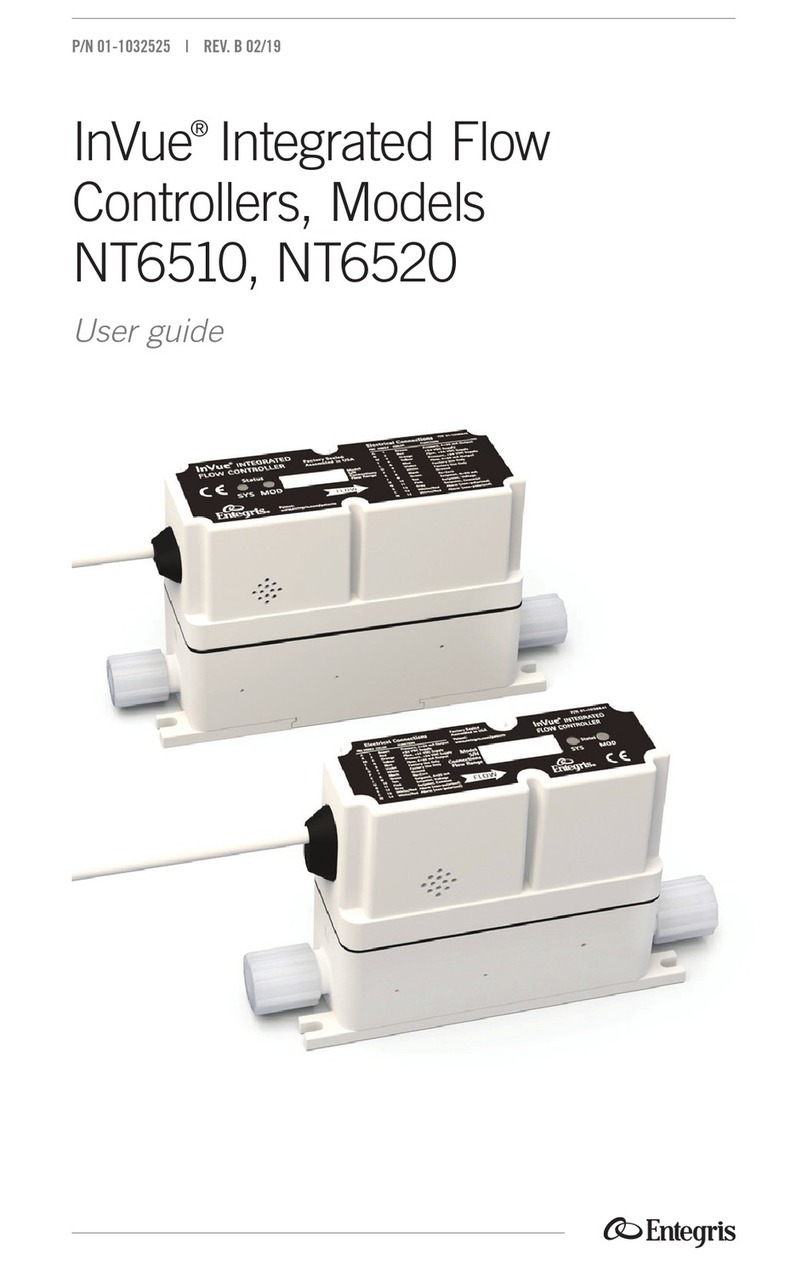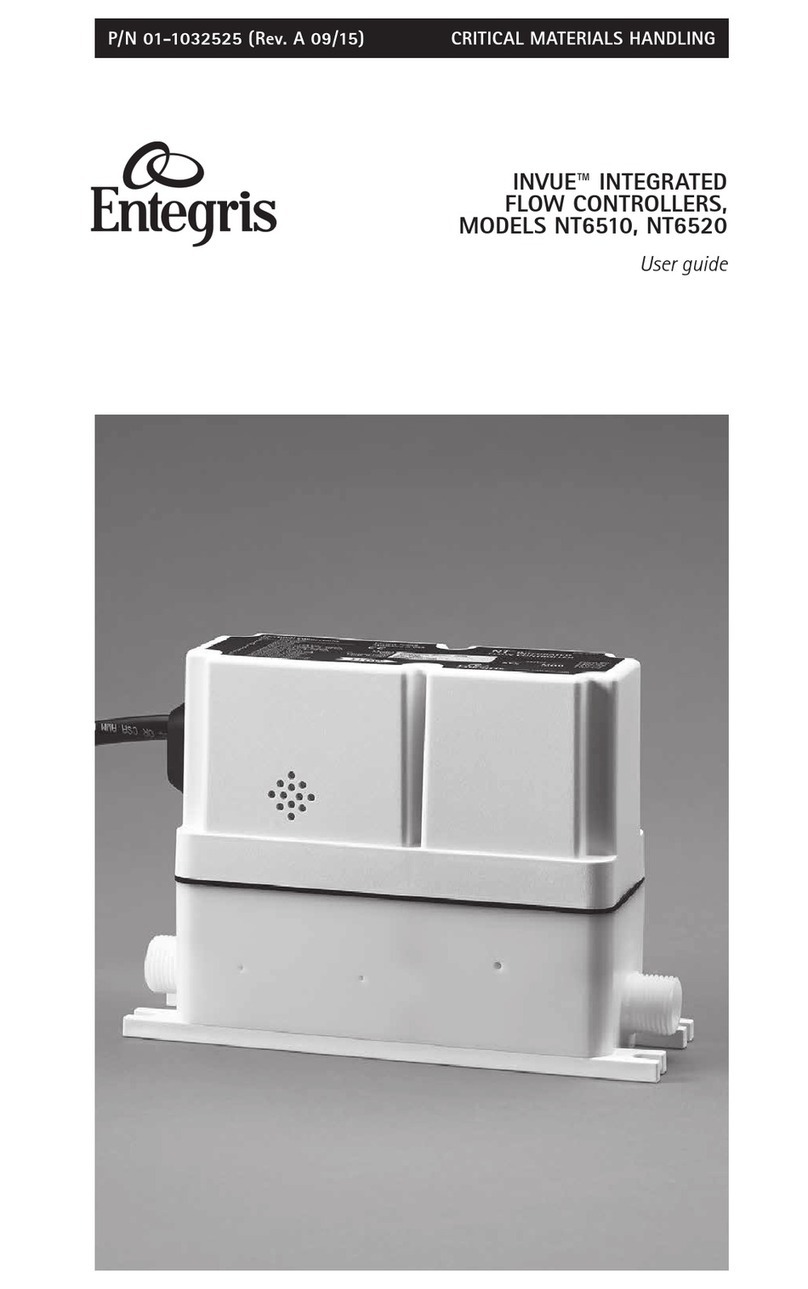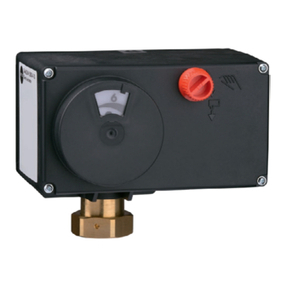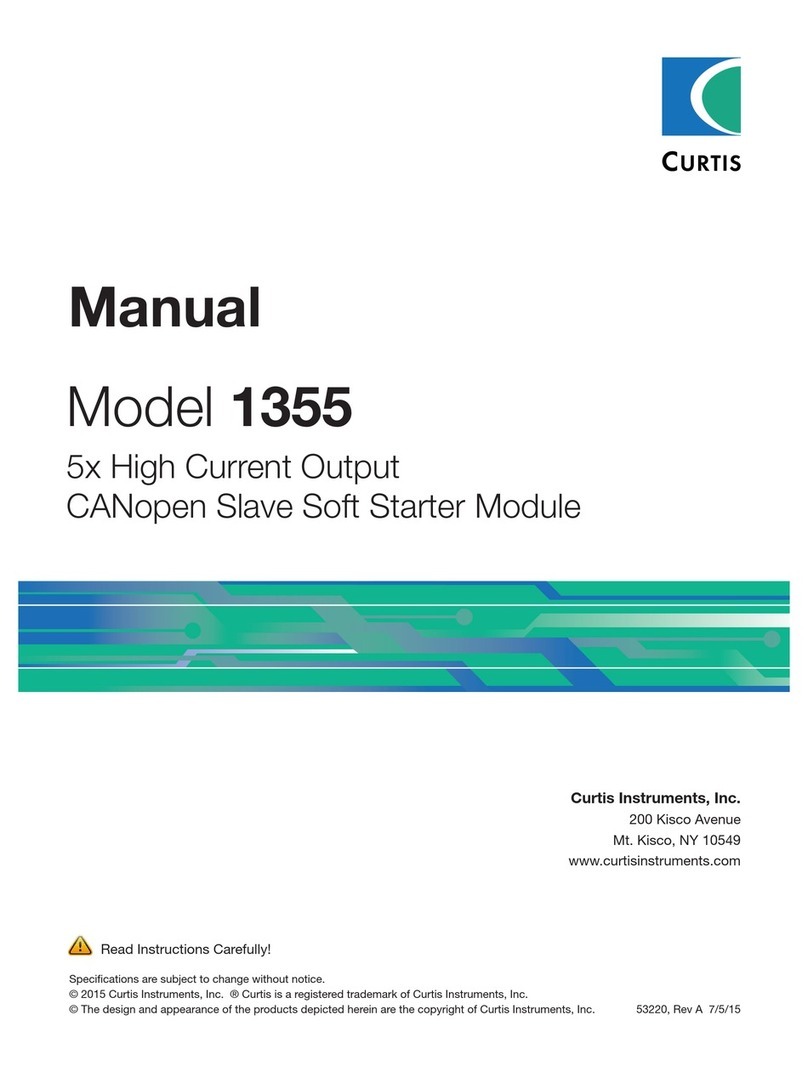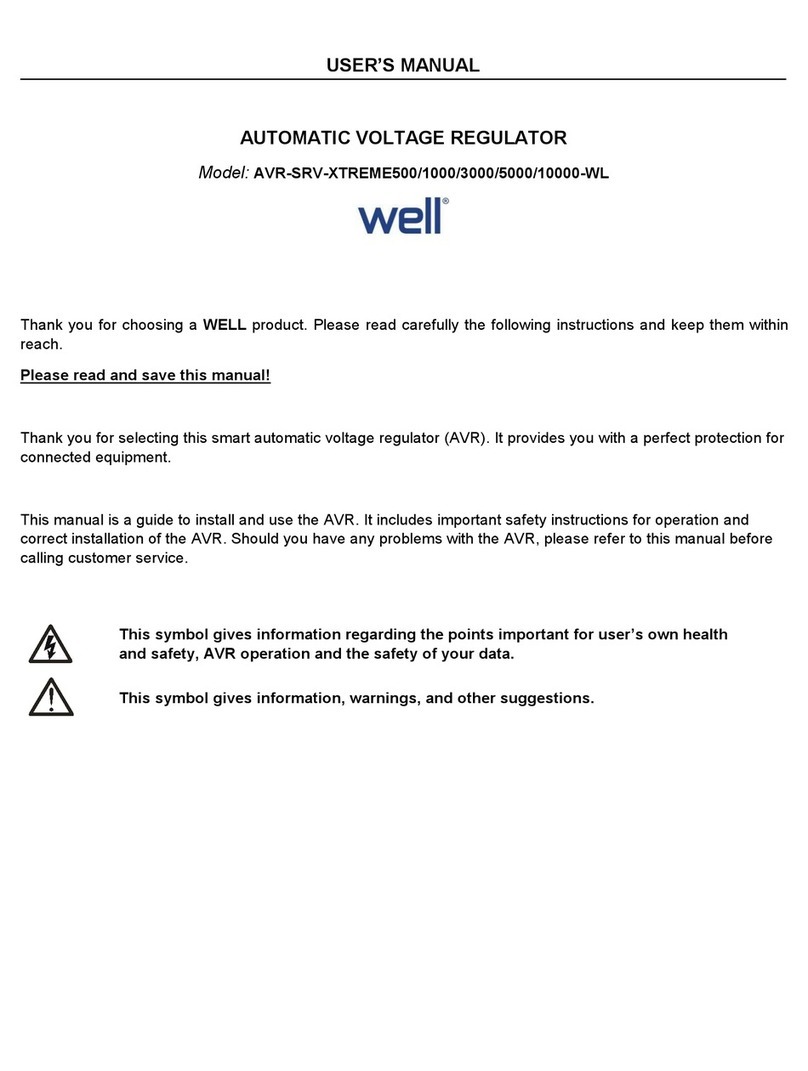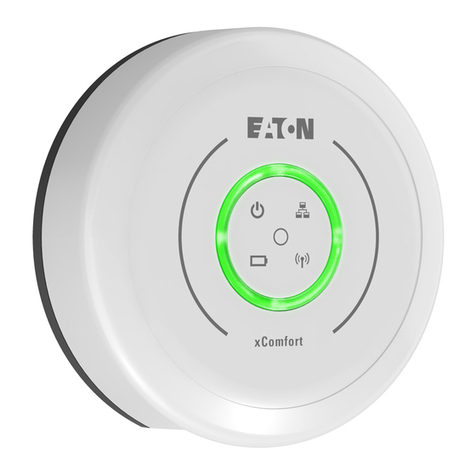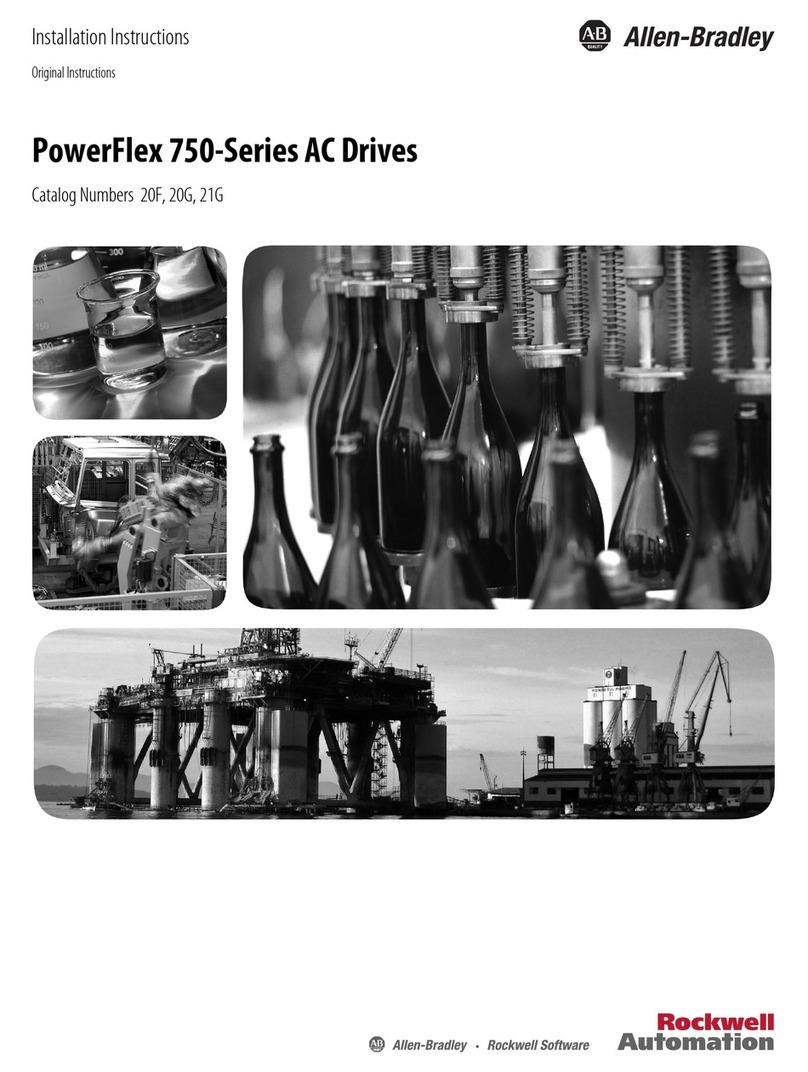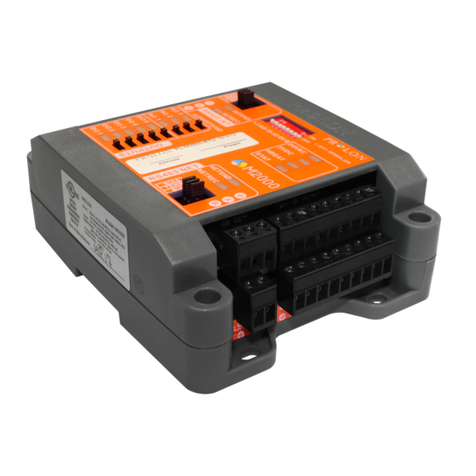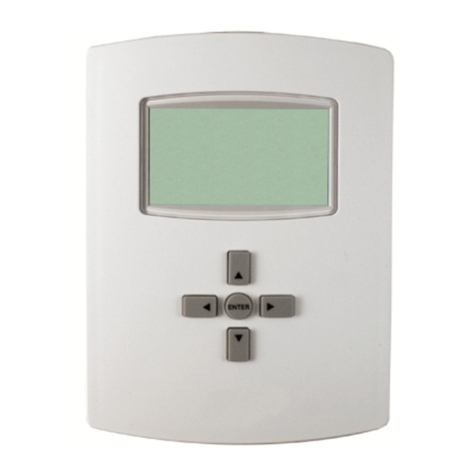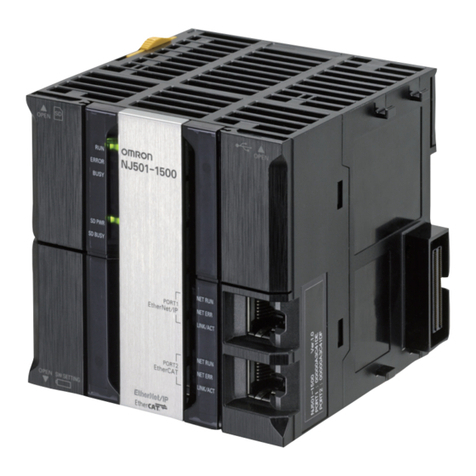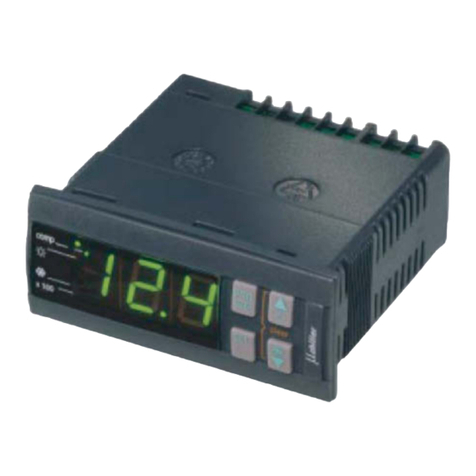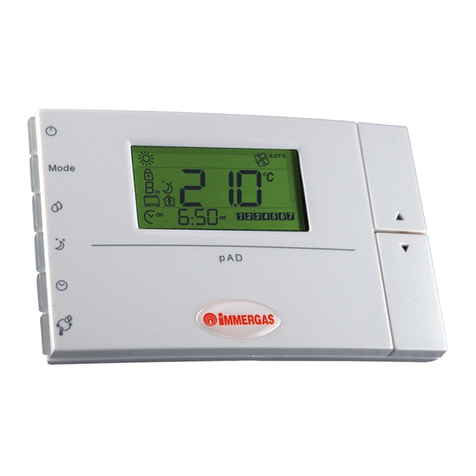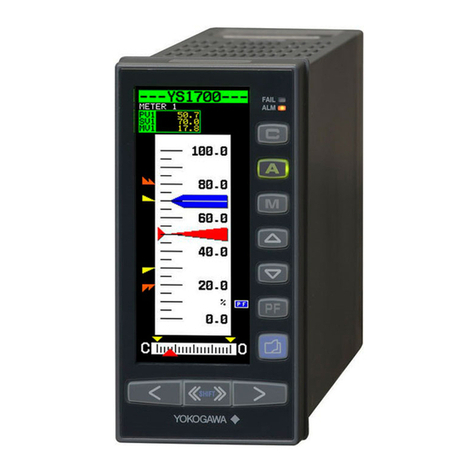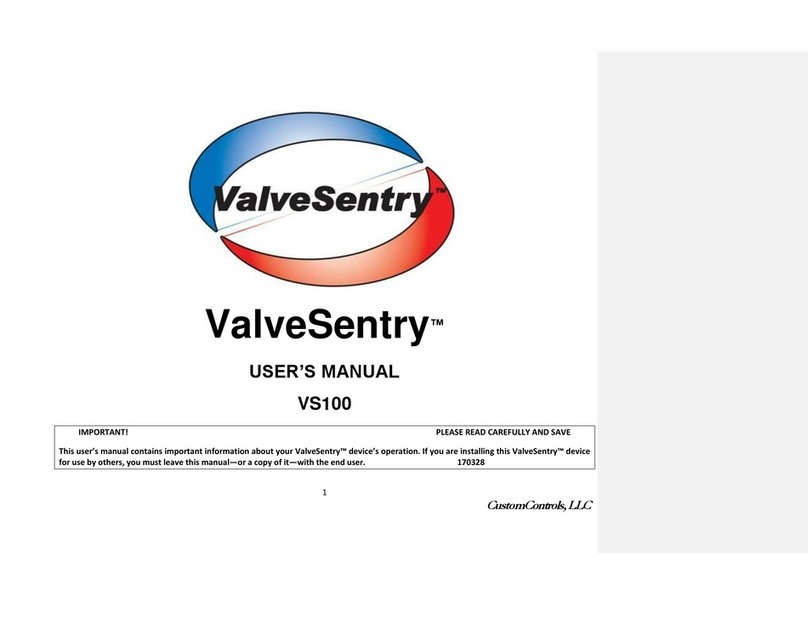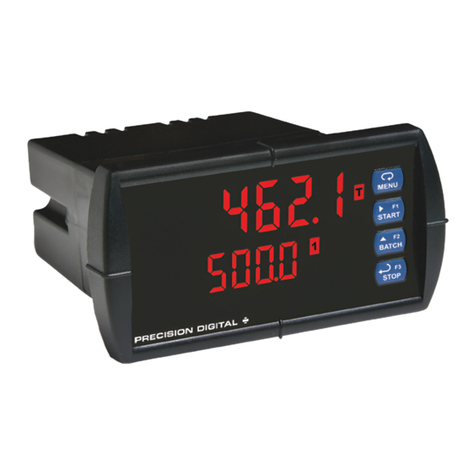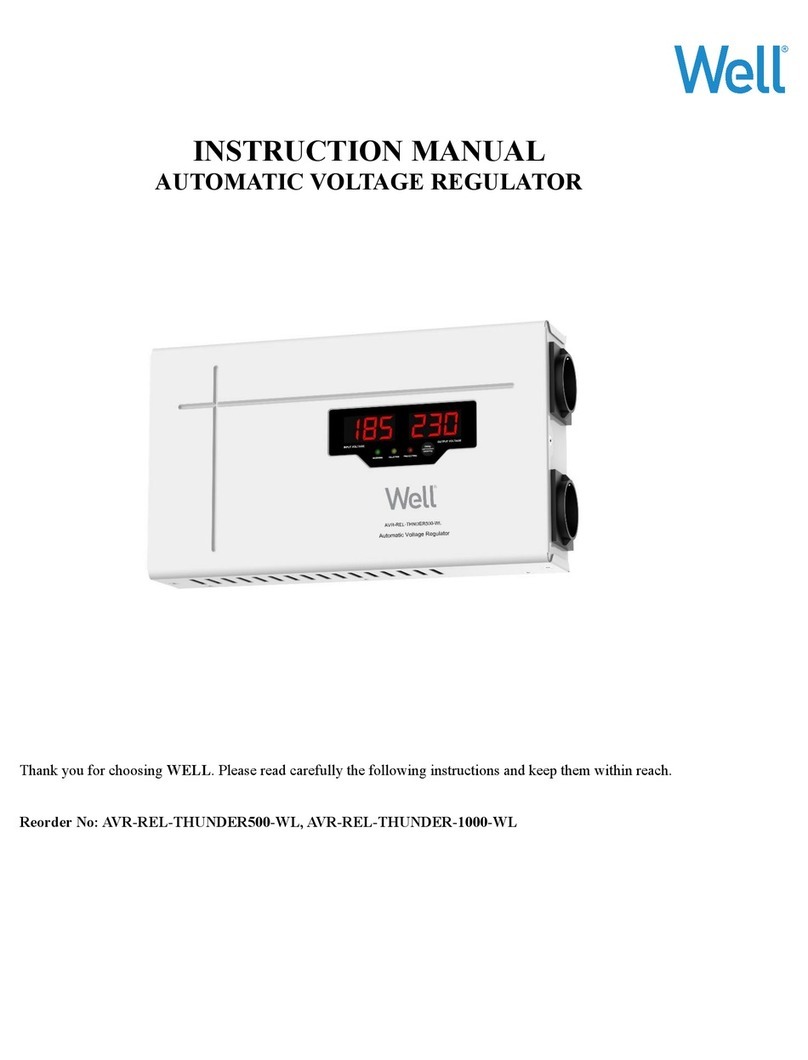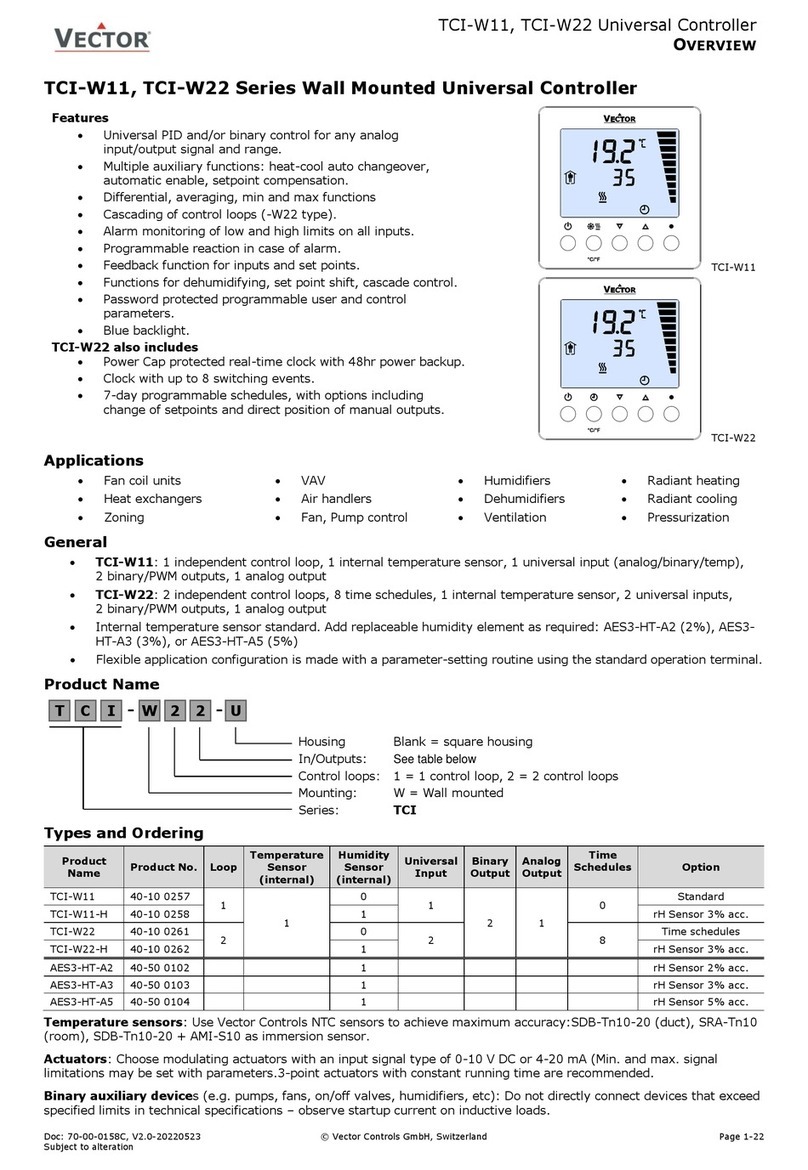entegris NT6500 User manual

NT™
Integrated Flow
Controller with DeviceNet™
Communication
User Guide
P/N 2608 | REV. B 05/19

1Entegris, Inc. | User Guide
NT INTEGRATED FLOW CONTROLLER WITH DEVICENET COMMUNICATION
Table of Contents
Introduction .................................. 2
Identifying Nonstandard
Product Configurations ............ 2
Principle of Operation .............. 2
Factory Configured ................... 3
Control Mode Functions .......... 3
Autozero Function .................... 3
Calibration Reference
Conditions ................................... 3
General Considerations .............. 4
Line Pressure .............................. 4
Pressure Drop ............................. 4
Ambient Temperature
Range ........................................... 4
Process Temperature
Range ........................................... 4
Storage Temperature
Range ........................................... 5
Power Supply
Requirements ............................. 5
DeviceNet Cable ........................ 5
DeviceNet Communication .... 5
Dimensions ................................. 8
Installation ..................................... 9
Mounting Requirements ........ 10
Mechanical Installation .......... 11
Electrical Connections ........... 12
Unit Operation ............................ 14
Operating Environment ......... 14
Performance ............................. 14
Reliability Information ............ 16
Diagnostic Guide ........................ 17
Maintenance ................................ 19
Normal Operation ................... 19
Re-zero Function .................... 19
Reference ..................................... 20
Ordering Information ................ 21
Certifications ............................... 22
DeviceNet Communication
Integrated Flow Controller
Device ........................................... 23
Device Type: 00hex ................... 23
Identity Object (01hex) ............. 27
Message Router
Object (02hex) ........................... 29
DeviceNet Object (03hex) ...... 30
Assembly Object (04hex) ......... 33
Connection Object (05hex) .... 36
S-Device Supervisor
Object (30hex) ........................... 40
S-Analog Sensor
Object (31hex) ............................ 46
S-Analog Actuator
Object (32hex) ........................... 54
S-Single Stage Controller
Object (33hex) ............................ 57
S-Sensor Calibration
Object (64hex) ........................... 59
For More Information ................ 62
Terms and Conditions
of Sale ........................................... 62
Limited Warranty ........................ 62

NT INTEGRATED FLOW CONTROLLER WITH DEVICENET COMMUNICATION
2User Guide | Entegris, Inc.
Introduction
This manual is for use with standard
NTTM Integrated Flow Controllers with
DeviceNetTM communication, Model
6500. These instruments have been
designed for use in high-purity appli-
cations in the semiconductor industry.
The wetted parts are constructed
with PTFE, PFA or other similar
high-purity inert materials.
WARNING! Attempting to install
or operate standard NT Integrated
Flow Controllers without review-
ing the instructions contained
in this manual could result in
personal injury or equipment
damage.
IDENTIFYING NONSTANDARD
PRODUCT CONFIGURATIONS
—
This User Guide applies to product
manufactured as the standard NT
Integrated Flow Controller. Entegris
also manufactures nonstandard prod-
uct to meet the needs of specific
applications. Nonstandard product
may have dierent materials of con-
struction, accuracy specifications,
performance and other specifications
that dierentiate the nonstandard
product from the standard oering.
NOTE: Nonstandard NT Integrated Flow
Controllers may be identified by the
model number found on the product
label. Specifications for nonstandard
NT Integrated Flow Controllers are
available by contacting Entegris.
Nonstandard NT Integrated Flow
Controllers, Model 6500 product line,
are identified with an “M" followed by
a number code.
Example part number:
6500-T2-F02-AM12-D-P7-U3-M02
The “M02" designates the product
as a nonstandard product manu-
factured to certain specifications
designated under the “M02" code.
PRINCIPLE OF OPERATION
—
The user provides a setpoint signal
that corresponds to the desired
amount of flow. The standard NT
Integrated Flow Controller compares
the setpoint to the actual flow signal
from the flow module. If the actual
flow is greater than the setpoint, the
unit closes the valve. If the actual
flow is less than the setpoint, the unit
opens the valve. The flow controller
does this in a precise manner until
the actual flow signal is equal to the
setpoint.
IFC control interface
MAC ID, baud rate, status LEDs
Flow module Valve module
Valve
control
Fluid flowFluid flowFluid flow
Power
DeviceNet I/O
Flow and pressure
measurement
Figure 1. System block diagram.

NT INTEGRATED FLOW CONTROLLER WITH DEVICENET COMMUNICATION
3Entegris, Inc. | User Guide
FACTORY CONFIGURED
—
The standard NT Integrated Flow
Controller is pre-configured from the
factory for the flow range specified
by the user. The specified flow range
is found on the label of the unit. The
unit control algorithm uses pressure
and flow measurements to ensure
proper operation within specification.
CONTROL MODE FUNCTIONS
—
There are two types of control mode
functions defined for this product:
Normal Operation: A setpoint input
of <5% of full scale will cause the
valve to close to a leak tight seal.
This is for batch applications where
the user is dispensing a given flow
rate for a given period of time.
Actuator Override: An actuator
override DeviceNet communication
message is sent to suspend control
and leave the valve in its present
position, regardless of setpoint
input value.
AUTOZERO FUNCTION
—
If autozero is enabled and the set-
point is set to <5%, the valve closes
and the flowmeter will enter into the
re-zero routine. Upon application
of a setpoint greater than or equal to
5%, a new dierential pressure (DP)
zero value will be stored in non-
volatile memory and the unit will
immediately resume operation.
Autozero is a selectable option
through DeviceNet communication
messaging with a default setting of
‘enabled’. It will not increase system
response time. The autozero routine
will determine DP zero values based
on a weighted average routine.
CALIBRATION REFERENCE
CONDITIONS
—
Unless otherwise noted, the specifi-
cations listed for the NT Integrated
Flow Controller with DeviceNet
communication are referenced under
the following operating conditions:
PARAMETER REFERENCE CONDITION
Process fluid Deionized water
Process
temperature
23°C ±3°C
(73°F ±5°F)
Ambient
temperature
23°C ±3°C
(73°F ±5°F)
Relative humidity 50% RH, ±10% RH
Process pressure 138 – 207 kPa
(20 – 30 psig)
Supply voltage 24 VDC, ±10%
Warm-up time 5 minutes
Orientation Horizontal
Operation Flowmeter zeroed

NT INTEGRATED FLOW CONTROLLER WITH DEVICENET COMMUNICATION
4User Guide | Entegris, Inc.
General Considerations
NOTE: The flow controller has been
factory sealed. Do not attempt to
remove the cover of the unit. Any
attempt at removal of the unit cover
will void the warranty.
LINE PRESSURE
—
The system line pressure (measured
at the inlet of the unit) must be
between 69 to 414 kPa (10 and
60 psig). The minimum operating
pressure is 69 kPa (10 psig).
PRESSURE DROP
—
The minimum pressure drop (dier-
ential pressure) required for the unit
is 69 kPa (10 psid).
For example, if the flow controller
is operating at an inlet pressure of
103 kPa (15 psig) and outputs the
flow to a pressurized canister, which
is pressurized to 69 kPa (10 psig), the
pressure available to the unit will be
34 kPa (5 psid) (i.e., 103 kPa [15 psig]
inlet pressure minus 69 kPa [10 psig]
back pressure is 34 kPa [5 psid] avail-
able pressure drop). This scenario
does not meet the pressure drop
requirement of 69 kPa (10 psid) and
the unit may not perform within
specification. For this example,
either increase the inlet pressure or
decrease the back pressure to obtain
a 69 kPa (10 psid) pressure drop.
AMBIENT TEMPERATURE RANGE
—
The flow controller is designed to
operate in room temperature clean-
room environments: 10° to 30°C
(50° to 86°F). The unit must be
re-zeroed at operating temperature
conditions for the accuracy specifi-
cations to apply.
PROCESS TEMPERATURE RANGE
—
The range of acceptable process
temperatures is 10° to 65°C (50° to
149°F). The flow controller must be
re-zeroed at operating temperature
conditions for the accuracy specifica-
tion to apply. PFA isolators are recom-
mended for process temperatures
higher than 50°C (122°F). Applications
involving hydrofluoric acid (HF) with
temperatures above 30°C (86°F) must
contact the factory for recommend-
ed materials of construction. Positive
pressure must be maintained at
all times.

NT INTEGRATED FLOW CONTROLLER WITH DEVICENET COMMUNICATION
5Entegris, Inc. | User Guide
STORAGE TEMPERATURE RANGE
—
The flow controller will withstand
storage temperatures between
-40° and 50°C (-40° and +122°F)
for at least a 24-hour period with
no permanent eect on device
performance.
POWER SUPPLY REQUIREMENTS
—
The power supply range for the
standard NT Integrated Flow Con-
troller is 24 VDC ±10%.
The power supply must provide
continuous 1.0 A (nominal) current
for each flow controller installed.
Peak power consumption is 1.2 A,
maximum.
The power supply to the flow con-
troller must provide clean power to
the unit and must be used only to
power similar measurement-type
devices. The power supply must
not be used to power other inductive
loads, such as motors, relays or sole-
noids. These devices may produce
electrical transients that may aect
unit measurements. An induced
power spike, creating an interruption
in power greater than 10 msec in
duration, may cause the unit to reset.
DEVICENET CABLE
—
The power supply range of the
DeviceNet cable is 24 VDC ±10%,
150 mA nominal current.
In addition to providing clean power,
all power communication cables
must not be run within the same
conduit or cable along with heavy
current demands from motors,
charging capacitors or other induc-
tive loads. This may cause a voltage
change within the instrumentation
signal line, causing erroneous output
readings from the flow controller.
Loss of power will not cause the loss
of any system parameters or calibra-
tion values.
DEVICENET COMMUNICATION
—
The DeviceNet communication shall
meet the physical layer communica-
tions requirements in the referenced
ODVA DeviceNet standard. Briefly,
this is a 5 wire (V+, V-, CAN_H,
CAN_L, Drain) physical layer based
on the CAN protocol.

NT INTEGRATED FLOW CONTROLLER WITH DEVICENET COMMUNICATION
6User Guide | Entegris, Inc.
DeviceNet Module Status LED
This LED is labeled ‘Mod’.
INTEGRATED FLOW
CONTROLLER STATE LED STATE DESCRIPTION
Power off O No power is applied through DeviceNet.
IFC self-test Flashing red
and green
IFC is in self-test.
IFC operational Green IFC is operating normally.
Minor fault Flashing red IFC has detected a recoverable fault.
Unrecoverable
fault
Red IFC has detected an unrecoverable fault.
IFC in standby Flashing green IFC needs commissioning due to configura-
tion missing, incomplete or incorrect.
DeviceNet Network Status LED
This LED is labeled ‘Net’.
INTEGRATED FLOW
CONTROLLER STATE LED STATE DESCRIPTION
Not powered or
not on-line
O IFC is not on-line. IFC may not be powered;
look at Module Status LED.
On-line, not connected Flashing green IFC is on-line, but has no connection.
Link OK, on-line,
connected
Green IFC is on-line and has connection.
Connection time-out Flashing red Network connection is in the timed-out state.
Critical link failure Red IFC has detected an error and cannot
communicate on the network.
Figure 2. DeviceNet switches and status LEDs
located on the top side of the flow controller.
Data Rate
Node Address
(00-63)
Net Mod
LSDMSD
PGM
PGM
500 Kb,2
125 Kb,0
250 Kb,1
24
6
8
0
24
6
0

NT INTEGRATED FLOW CONTROLLER WITH DEVICENET COMMUNICATION
7Entegris, Inc. | User Guide
DeviceNet Node Address
Switches
Two, ten-position, rotary switches
used for configuring the Media
Access Control Identifier (MACID)
of the flow controller. These switches
specify the MACID using decimal
representation. One switch specifies
the most significant digit (MSD), or
tens position of the MACID. The
second switch specifies the least
significant digit (LSD) or the ones
position of the MACID. DeviceNet
allows MACIDs with values 0 – 63.
The “PGM" label indicates the soft-
ware programmable switch positions.
DeviceNet Data Rate Switch
A single, ten-position rotary switch
used for configuring the baud rate
of the flow controller. The switch
has positions for the three valid,
DeviceNet data rates, 125, 250 and
500 Kbaud. Switch position 0 selects
125 Kb, position 1 selects 250 Kb, and
position 2 selects 500 Kb. The “PGM"
label indicates the software program-
mable switch positions.
Electrical Isolation
The degree of electrical isolation
between power and DeviceNet
communication is as listed below:
From Power, 24 VDC
To DeviceNet Comm
Isolation degree >500 VAC/VDC
Reverse Polarity Protection
The flow controller is reverse polarity
protected; connecting the 24 VDC
power to the incorrect positive and
ground wires will not harm the unit.
To operate properly, the polarity must
be correct.
Over-Voltage on any Wire (DC)
The flow controller will withstand
the continuous application of 30 VDC
on any wire without compromising
the unit.
Over-Voltage on any Wire (AC)
The flow controller is not designed to
withstand the accidental application
110/220 VAC to any wire. Application
of AC voltage will damage the unit.
Short Protection
The flow controller will not be
damaged or compromised in any
way if any combination of wires
are shorted together.

NT INTEGRATED FLOW CONTROLLER WITH DEVICENET COMMUNICATION
8User Guide | Entegris, Inc.
DIMENSIONS
—
DIMENSION
FLARETEK
FITTING A B C D
¹/4" 123.4 mm (4.86") 130 mm (5.12") 19.6 mm (0.77") 244.1 mm (9.61")
³/8"123.4 mm (4.86") 130 mm (5.12") 19.6 mm (0.77") 247.7 mm (9.75")
¹/2"127 mm (5.00") 133.6 mm (5.26") 21.6 mm (0.85") 251.7 mm (9.91")
³/4"134.9 mm (5.31") 141.5 mm (5.57") 25.7 mm (1.01") 257.8 mm (10.15")
NT Integrated Flow Controller with DeviceNet Communication
65.5 mm
(2.58")
Top View
Side View
Front View
A B
D
C
217.2 mm (8.55")
230.4 mm (9.07")
72.9 mm
(2.87")
47 mm
(1.85")
7.1 mm
(0.28")

NT INTEGRATED FLOW CONTROLLER WITH DEVICENET COMMUNICATION
9Entegris, Inc. | User Guide
Installation
Provided Equipment
CAUTION! Do not tighten the
nuts that protect the flared tube
connections during shipment.
(See Prepare Fluid Lines on page
11). Tightening these nuts without
the proper tubing installed may
damage the unit’s flared tube
connections.
Remove Unit from the Bag
NOTE: This unit has been assembled
and double-bagged under cleanroom
conditions. To maintain purity, only
open under cleanroom conditions.

NT INTEGRATED FLOW CONTROLLER WITH DEVICENET COMMUNICATION
10 User Guide | Entegris, Inc.
MOUNTING REQUIREMENTS
—
The flow controller may be mounted
in any orientation. The unit does not
require straight lengths of tubing at
the inlet or the outlet connection.
Mount the Unit
The flow controller and base bracket
assembly must be mounted to a solid
surface to ensure stability. Verify the
valve and the electrical cable are free
from mechanical stress from the
surrounding equipment.
NOTE: The flow controller requires
mounting in the direction of the
fluid flow.
#10 (M4)
Pan head
#10 (M4)
Flat washer
Recommended
Hardware
47.0 mm
(1.85")
217. 2 mm
(8.55")

NT INTEGRATED FLOW CONTROLLER WITH DEVICENET COMMUNICATION
11Entegris, Inc. | User Guide
MECHANICAL INSTALLATION
—
The standard NT Integrated Flow
Controller must be used with the
proper tubing size and fittings.
To prepare the fluid lines, begin by
sliding the supplied nuts onto the
fluid tube.
Prepare Fluid Lines
Connect Fluid Lines
NOTE: Flare each tube end prior to
installation onto the valve fitting.
CAUTION! Overtightening of
the nuts will result in damage
to the fittings.
Process
fluid tube
Slide the nut onto the tub
e
Process
fluid tube
Flare each tube end
prior to installation

NT INTEGRATED FLOW CONTROLLER WITH DEVICENET COMMUNICATION
12 User Guide | Entegris, Inc.
When installing flared tubing to the
flow controller, the flared tube is
pushed over the valve’s fitting until
the fitting reaches the smaller tube
diameter. The amount of torque
required to tighten the nut is depen-
dent upon the size of the fitting.
FITTING
SIZE 1⁄4"3⁄8"1⁄2"3⁄4"
Torque
N•m
(in•lbs)
0.56
(5)
0.90
(8)
1.24
(11)
1.58
(14)
Care should be taken when installing
the flow controller to avoid fluid leaks.
Do not use excessive torque or sub-
ject the unit to high heat during install-
ation. The unit and base bracket as-
sembly must be mounted to a solid
surface to ensure stability. Verify the
body and the electrical cable are free
from mechanical stress from the
surrounding equipment.
ELECTRICAL CONNECTIONS
—
Connect cable to flow controller
The cable mounting receptacles
are physically “keyed”, making it
impossible to insert the connector
improperly. Press it into the mount-
ing receptacle and rotate the outer
coupling ring to lock the connector
in place. To remove the connector,
rotate the coupling ring in the
opposite direction.
Power Cable
Cable materials are constructed
with 22 AWG wire and a PVC jacket.
The connector is a 4-pin, 12 mm,
male type.
FUNCTION
PIN
ASSIGNMENT COLOR
No connection 1Brown
+24V 2White
24V common 3Blue
No connection 4Black
DeviceNet
communication
cable
Power
cable
1 Drain
2 V+ Red
3 V– Black
4 CAN_H White
5 CAN_L Blue
1 N/C
2 +24V
3 24V COM
4 N/C

NT INTEGRATED FLOW CONTROLLER WITH DEVICENET COMMUNICATION
13Entegris, Inc. | User Guide
DeviceNet Cable
Cable materials are constructed with
22 AWG wire and a PVC jacket. The
connector is a 5-pin, micro-style,
12 mm, male type.
FUNCTION
PIN
ASSIGNMENT COLOR
Drain 1Bare wire
V+ 2Red
V- 3Black
CAN_H 4White
CAN_L 5Blue
NOTE: The allowable torque on
the 8-32 × ⁄" PVDF screws used to
secure the clear switch access cover
is 7 Newton-centimeters.
MSD
LSD
Data rate
Data Rate
Node Address
(00-63)
Net Mod
LSDMSD
PGM
PGM
500 Kb,2
125 Kb,0
250 Kb,1
24
6
8
0
24
6
0

NT INTEGRATED FLOW CONTROLLER WITH DEVICENET COMMUNICATION
14 User Guide | Entegris, Inc.
Unit Operation
OPERATING ENVIRONMENT
—
Operating Temperature
The flow controller is designed to
operate in ambient temperature,
cleanroom environments. The unit
is specified to operate at tempertures
between 10° and 65°C (50° and
149°F). PFA sensor isolators are re-
commended for process tempera-
tures above 40°C (104°F). Contact the
factory for recommended materials
of construction for applications
involving hydrofluoric acid (HF) with
temperatures above 30°C (86°F).
When the process fluid is above
ambient temperatures 23°C (73°F),
the system will experience slight
accuracy errors due to instrument
warm-up and changes in viscosity
and specific gravity of the liquid.
The unit must be re-zeroed after
any temperature change. Please
see the Maintenance Section on
page 19 to perform the re-zero.
Eects of Fluid Viscosity and
Specific Gravity
The flow controller has been factory
calibrated using deionized water.
Fluids with viscosities and/or specific
gravity dierent from the calibration
fluid (water) will cause slight accuracy
errors. Correction factors for viscosity
and specific gravity changes may be
obtained from Entegris by calling or
following the sensing and control
product links at www.entegris.com.
Power-up Characteristics
When power is first applied to the
flow controller, the flow will be within
2% of the setpoint value in less than
10 seconds and within specification
after 5 minutes. As part of the power-
up routine, the unit will perform a
homing routine that re-establishes
the unit’s fully closed position. This
routine requires the valve to shut
completely for no more than
8 seconds, then to the position
dictated by the setpoint input.
Unit Enclosure
The standard NT Integrated Flow
Controller cover is factory sealed
and should not be tampered with
or opened. Spray-down will not
compromise the performance of
the unit.
NOTE: Any attempt to remove, tamper
or open the flow controller cover will
void the warranty.
PERFORMANCE
—
Operating Pressure Requirements
The flow rate is calculated using
Entegris’ dierential pressure flow
technology. The minimum operating
pressure is 69 kPa (10 psig). The mini-
mum pressure drop (dierential
pressure) required for the flow
controller is 69 kPa (10 psid).
CAUTION! The flow controller may
be damaged if it is subjected to any
level of vacuum pressure (less than
atmospheric pressure).

NT INTEGRATED FLOW CONTROLLER WITH DEVICENET COMMUNICATION
15Entegris, Inc. | User Guide
NOTE: To perform within specification,
the available inlet pressure must be
69 kPa (10 psid) greater than the outlet
pressure (69 kPa [10 psid] dierential
pressure).
Flow Accuracy
The accuracy of the flow mea-
surement is ±1% of full scale from
20–100% of the flow range. The
accuracy of the flow measurement
is ±2.5% of full scale from 10–20%
of the flow range. The accuracy
spec ification includes the eects of
linearity, hysteresis and repeatability,
using deionized water at 23°C (73°F).
The accuracy between 0–10% of full
scale flow range is not specified.
Flow accuracy is verified by testing
the unit at stable conditions for a
period of 20 seconds or longer using
deionized water at 23°C (73°F).
To meet the accuracy specification,
a re-zero is required for every 69 kPa
(10 psig) change in line pressure.
Response Time
Response time is defined as the
length of time required for the mea-
sured flow rate to be within the full
scale (FS) accuracy specification.
The typical response time is within
3 seconds from 10% to 95%SP.
The flow controller will respond to
setpoint changes within 50 msec of
receiving the new setpoint value.
Pressure Measurement Accuracy
The accuracy of the pressure
output is ±1% of full scale. These
calcula- tions include the eects
of linearity, hysteresis and repeat-
ability, measured at 23°C (73°F).
Minimum Operating Pressure
The unit will operate within speci-
fication at any inlet pressure within
the range of 69 to 414 kPa (10-60
psig) and a minimum pressure drop
of 69 kPa (10 psid).
Temperature Increase of Flow
Controller Enclosure
The temperature increase within the
unit enclosure will be less than 30°C
(86°F). The temperature increase at
the exterior of the unit cover will be
less than 25°C (77°F).
The temperature increase of the
process fluid will be less than 3°C
(5°F) at 10% of flow and less than
0.5°C (0.9°F) at 100% of flow range
for the following product flow ranges:
0 – 50mL, 0 – 125 mL, 0 – 250 mL,
0 – 500 mL, 0 – 1250 mL. For all other
flow ranges, the temperature rise of
the process fluid is negligible, less
than 0.5°C (0.9°F), at all flows. Under
extended static flow conditions (i.e.,
no flow for >24 hours) the tempera-
ture increase of the process fluid will
be less than 15°C (27°F).
Warm-up Time
The flow controller requires a
warm-up time of 10 minutes after
power is applied. Warm-up time is
typically not required if the unit was
operated within 3 hours.

NT INTEGRATED FLOW CONTROLLER WITH DEVICENET COMMUNICATION
16 User Guide | Entegris, Inc.
RELIABILITY INFORMATION
—
Redundant Process Seals
All internal process wetted seals are
redundant (i.e., there is a secondary
seal that prevents process fluid from
reaching the interior of the device
in the case of a primary seal failure).
Weep holes are provided from the
secondary containment regions.
Long-term Reliability
The valve system can withstand
3.5 million open/close cycles
before the control performance
is compromised.
Enclosure Integrity
Spray down of the flow controller will
not aect the performance per IP54.
Drop and Topple
If the unit topples over from a
45-degree angle onto a bench top,
the performance will not be com-
promised and the unit will not be
externally damaged.
Cable Pull
The cable will withstand a static
pull test of 9.1 kg (20 lbs) straight
and 4.5 kg (10 lbs) at 90 degrees
without being damaged.

NT INTEGRATED FLOW CONTROLLER WITH DEVICENET COMMUNICATION
17Entegris, Inc. | User Guide
Diagnostic Guide
SYMPTOM POSSIBLE CAUSES SUGGESTIONS
1. Flow reading is very low. The unit is installed
backwards.
Install the unit so the inlet
flow is plumbed on the
same side as the electrical
connection.
Insucient line pressure. The inlet pressure must
be at least 69 kPa (10 psig)
greater than the outlet
pressure. Verify the inlet
pressure using the pres-
sure signal from the flow
controller.
2. Flow reading above zero
when set point is zero
and no flow is present.
The unit needs to be
re-zeroed.
Perform a zero adjust
service or enable the
autozero function.
3. Flow output is extremely
noisy.
The actual fluid flow
conditions are noisy.
Flow turbulence may be
caused by “noisy” pumps
used in a system. Examples
of noisy pumps are dia-
phragm pumps without
pulsation dampeners and
peristaltic pumps operating
at low flow rates. Please
contact Entegris for
additional information.
4. Unit resets. The supply power (+24V)
is noisy.
If the power supply is
shared with other systems,
components (such as
solenoids, DC motors,
valves, etc.) the unit may
be receiving “dirty” power.
Extreme noise spikes will
cause the unit to reset.
Connect the unit to a
separate power source.
5. Flow output does not
correspond to set point
for high flow rates.
Inlet pressure is not 69 kPa
(10 psig) greater than the
outlet pressure at the high
flow conditions.
Measure the inlet pressure.
Also measure the fluid pres-
sure at the outlet of the unit
using a pressure gauge or
pressure transducer. Verify
the inlet pressure is at least
69 kPa (10 psig) greater than
the outlet pressure.

NT INTEGRATED FLOW CONTROLLER WITH DEVICENET COMMUNICATION
18 User Guide | Entegris, Inc.
SYMPTOM POSSIBLE CAUSES SUGGESTIONS
6. Flow rate is not meeting
desired set point within
10 seconds or longer.
The unit is receiving a set-
point signal with no fluid
flow present. The flow
controller valve is moved
to the full-open position.
Depending upon flow range,
the unit may require 10–15
seconds or more to move
from the full-open position
to the correct setpoint
position.
Do not send a setpoint
signal to the unit when no
fluid flow is available.
Inlet pressure is not 69 kPa
(10 psig) greater than outlet
pressure.
See above, Symptom 5.
7. Flow output is not
responsive to changes
in setpoint signal.
Valve in full-open position.
If the unit is plumbed be-
tween two closed valves,
the unit may stall in the
full-open position when the
unit is commanded to close.
Since a fixed volume of fluid
is incompressible, the unit
may stall when attempting
to close if upstream and
downstream valves are
closed.
Avoid conditions of simul-
taneously closed valves
upstream and downstream
of the unit. The unit can
be returned to normal
operation by performing
a re-zero, or by cycling
power.
8. Net LED flashes green.
Valve goes to safe position,
default position is closed.
Network down. Reconnect to network.
Diagnostic Guide (continued)

NT INTEGRATED FLOW CONTROLLER WITH DEVICENET COMMUNICATION
19Entegris, Inc. | User Guide
Maintenance
NORMAL OPERATION
—
During normal operation, the stan-
dard NT Integrated Flow Controller
with DeviceNet communication
requires no maintenance, other than
a periodic re-zero of the unit.
RE-ZERO FUNCTION
—
The no flow calibration of the flow
controller can be re-zeroed, meaning
that the flow output that corresponds
to zero flow may be reset.
NOTE: When executing the re-zero
function, there must be at least 7 kPa
(1 psig) of static pressure. Optimum
pressure for re-zero is the operation
pressure, typically greater than 69 kPa
(10 psig).
NOTE: The following procedure must
be followed precisely to ensure proper
flow controller re-zero.
The no flow calibration of the flow
controller can be re-zeroed, meaning
that the flow output that corresponds
to zero flow may be internally reset.
This is done with DeviceNet service
requests. The ‘Zero_Adjust’ service
command in the Analog Sensor
Object is sent to begin a re-zero
process. The ‘Stop_Zero_Adjust’
service command in the Analog
Sensor Object is sent to stop the
re-zero process.
When the re-zero function is
activated, the flow controller valve
module will close fully to ensure that
fluid is not flowing. The unit will verify
the no-flow condition, and then re-
zero the flow module. The entire
re-zero function is completed in
10 seconds.
In order to obtain best performance,
the re-zero function should be
performed, at minimum if possible,
every day of service when operating
at ambient temperature conditions.
The re-zero function should be per-
formed more often if operating at
higher temperature. It is also recom-
mended to perform a re-zero after
start-up and after fluid temperature
changes of greater than 5°C (41°F).
Best performance will be achieved
by re-zeroing between each dis-
pense cycle.
Autozero Function
The no flow calibration of the flow
controller can be autozeroed,
meaning that the flow output that
corresponds to zero flow may be
automatically, internally reset when-
ever the setpoint is zero. Selecting
the ‘enabled’ setting of the ‘Autozero
Enable’ attribute in the Analog Sensor
Object does this. This is the default
setting.
Other manuals for NT6500
1
Table of contents
Other entegris Controllers manuals
